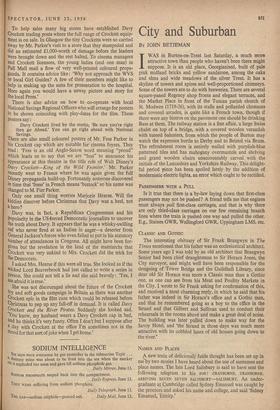City and Suburban
BY JOHN BETJEMAN IWAS in Burton-on-Trent last Saturday, a much more attractive town than people who haven't been there might suppose. It is an old place, Georgianised, built of pale pink midland bricks and yellow sandstone, among the oaks and elms and wide meadows of the silver Trent. It has a skyline of towers and spires and well-proportioned chimneys. Some of the towers are to do with breweries. There are several square-paned Regency shop fronts and elegant terraces, and the Market Place in front of the Tuscan parish church of St. Modwen (1719-26), with its stalls and pollarded chestnuts and covered arcades, is quite like a French town, though if there were any bistros on the pavement one should be drinking Bass at them. The railway station is a fine affair, a large Swiss chalet on top of a bridge, with a covered wooden verandah with turned balusters, from which the people of Burton may watch the expresses hurtle to Derby and to Bristol via Brum. The refreshment room is entirely walled with purplish-blue patterned tiles and has mahogany overmantels and shelving and grand wooden chairs unaccountably carved with the initials of the Lancashire and Yorkshire Railway. This delight- ful period piece has been spoiled lately by the addition of modernistic electric lights, an error which ought to be rectified.
PASSENGERS WITH A PULL
Is it true that there is a by-law laying down that first-class passengers may not be pushed? A friend tells me that engines must always pull first-class carriages, and that is why there are only third-class carriages on our few remaining branch lines where the train is pushed one way and pulled the other. E.g., Staines GWR, Wallingford GWR, Uppingham LMS, etc.
CLASSIC AND GOTHIC
The interesting obituary of Sir Frank Brangwyn in The Times mentioned that his father was an ecclesiastical architect. Some years ago I was told by an old architect that Brangwyn Senior had been chief draughtsman to Sir Horace Jones, the City surveyor, and might well have been responsible for the designing of Tower Bridge and the Guildhall Library, since dear old Sir Horace was more a Classic man than a Gothic one, as one can see from his Meat and Poultry Markets in the City. I wrote to Sir Frank asking for confirmation of this, and received a most charming reply, in which he said that his father was indeed in Sir Horace's office and a Gothic man, and that he remembered going as a boy to the office in the Strand and that Gilbert and Sullivan used to conduct their rehearsals in the rooms above and make a great deal of noise. The building was later pulled down to make way for the Savoy Hotel, and 'the Strand in those days was much more attractive with its cobbled lanes of old houses going down to the river.'
NAMES AND PLACES
A new train of deliciously futile thought has been set up in me by two stories I have heard about the use of surnames and place names. The late Lord Salisbury is said to have sent the following telegram to his son : CRANBORNE, CRANBORNE. ARRIVING SEVEN SEVEN SALISBURY—SALISBURY. An under- graduate at Cambridge called Sydney Emanuel was caught by the proctors and asked his name and college, and said 'Sidney Emanuel, Trinity.'


































 Previous page
Previous page